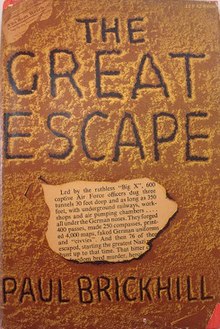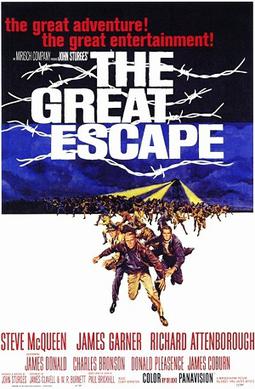
The Great Escape is a 1963 American epic historical war adventure film starring Steve McQueen, James Garner and Richard Attenborough and featuring James Donald, Charles Bronson, Donald Pleasence, James Coburn, Hannes Messemer, David McCallum, Gordon Jackson, John Leyton and Angus Lennie. It was filmed in Panavision, and its musical score was composed by Elmer Bernstein.
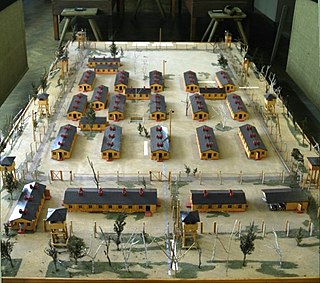
Stalag Luft III was a Luftwaffe-run prisoner-of-war (POW) camp during the Second World War, which held captured Western Allied air force personnel.
Sgt Per Bergsland was a Norwegian fighter pilot and POW in the German POW camp Stalag Luft III and one of only three men to escape to freedom in the "Great Escape".

Jens Einar Müller was a Norwegian pilot trained in Little Norway in Canada and a prisoner of war in the German POW camp Stalag Luft III. He was one of only three men to escape to freedom in the "Great Escape".
Paul Chester Jerome Brickhill was an Australian fighter pilot, prisoner of war, and author who wrote The Great Escape, The Dam Busters, and Reach for the Sky.
Squadron Leader Roger Joyce Bushell was a South African in the British Royal Air Force aviator. He masterminded the famous "Great Escape" from Stalag Luft III in March 1944, but was one of the 50 escapees to be recaptured and subsequently shot and murdered by the Nazi German Gestapo secret police.
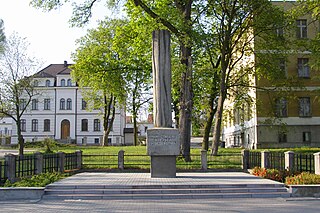
Oflag XXI-B and Stalag XXI-B were World War II German prisoner-of-war camps for officers and enlisted men, located at Szubin a few miles southwest of Bydgoszcz, Poland, which at that time was occupied by Nazi Germany.
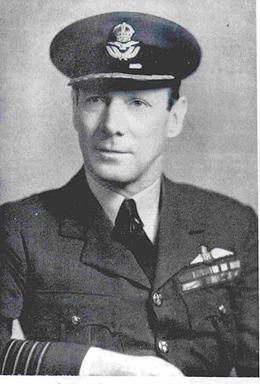
Harry Melville Arbuthnot Day, was a Royal Marine and later a Royal Air Force pilot during the Second World War. As a prisoner of war, he was senior British officer in a number of camps and a noted escapee.
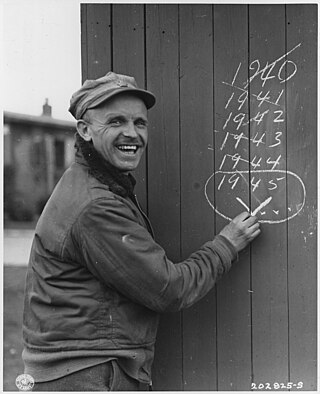
Dulag Luft were German Prisoner of War (POW) transit camps for captured airmen from any of the allied air forces during World War II. Their main purpose was to act as collection and interrogation centres for newly captured aircrew, before they were transferred in batches to the permanent camps.

Major John Bigelow Dodge, also known as "the Artful Dodger", was an American-born British Army officer who fought in both world wars and became a notable prisoner of war during the Second World War, surviving the famous The Great Escape in March 1944.

Tre kom tilbake is an autobiographical book from 1946 written by Norwegian pilot Jens Müller on his war experiences during World War II. The book centers particularly on his participation in the 1944 mass escape from the German prisoner-of-war camp Stalag Luft III. An English-language translation was published in 2019.
Flight Lieutenant Paul Gordon Royle was an Australian Royal Air Force pilot who was one of the last two survivors of the 76 men who were able to escape from the Stalag Luft III German prisoner-of-war camp in World War II in what became known as The Great Escape.

Leslie George Bull, known as Johnny, Les or Lester Bull, was a British Vickers Wellington bomber pilot who was taken prisoner during the Second World War. He took part in the 'Great Escape' from Stalag Luft III in March 1944, but was one of the men re-captured and subsequently shot by the Gestapo.

Michael James Casey, was a British Blenheim bomber pilot of Irish descent who was taken prisoner during the Second World War. He took part in the 'Great Escape' from Stalag Luft III in March 1944, but was one of the men re-captured and subsequently shot by the Gestapo.

Arnold George Christensen was a New Zealand Mustang fighter pilot who was taken prisoner during the Second World War during the Dieppe Raid, he is notable for the part he took in the 'Great Escape' from Stalag Luft III in March 1944 and as one of the men recaptured and subsequently executed by the Gestapo.

Edgar Spottiswoode Humphreys, known as Hunk, was a British Bristol Blenheim bomber pilot who was taken prisoner during the Second World War. He took part in the 'Great Escape' from Stalag Luft III in March 1944, but was re-captured and subsequently shot by the Gestapo.

Gordon Arthur Kidder, was a Royal Canadian Air Force officer, the navigator of a Vickers Wellington bomber, who was taken prisoner during the Second World War. He took part in the 'Great Escape' from Stalag Luft III in March 1944, but was one of the men recaptured and subsequently shot by the Gestapo.
Włodzimierz Adam Kolanowski was a Polish Vickers Wellington bomber "Observer and Captain" flying from England when he was taken prisoner during the Second World War. He took part in the 'Great Escape' from the Stalag Luft III prisoner of war camp in March 1944 and was one of the men recaptured and subsequently shot by the Gestapo.
Stanisław Zygmunt "Danny" Król was a Polish Supermarine Spitfire fighter pilot flying from England when he was taken prisoner during the Second World War. He is notable both as a persistent escaper and for the part he played in the 'Great Escape' from Stalag Luft III in March 1944 being one of the men recaptured and shot by the Gestapo.
Jerzy Mondschein was a Polish Vickers Wellington bomber Observer (navigator) flying from England when he was taken prisoner during the Second World War. He took part in the 'Great Escape' from Stalag Luft III in March 1944 and was one of the men recaptured and subsequently shot by the Gestapo.
